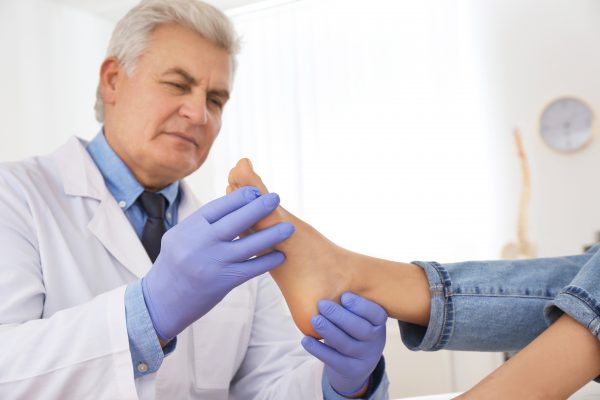If you notice a lump on the top or side of your foot that you are unsure of, it’s definitely something worth investigating.
While calluses and corns can form rounded masses of dead skin around your toes or on the bottom of your foot and can cause rubbing and pain, ganglion cysts are typically softer, painless lumps. The word “ganglion” means knot, and a ganglion cyst looks like a mass or knot formed on the top of your foot, hence the name.
Let’s learn more about ganglion cysts and how to treat this lump on the top of your foot:
What is a Ganglion Cyst?
Ganglion cysts are filled with a fluid, jellylike substance that forms a knot-like mass below the skin’s surface. It originates from the joint capsule or tendon sheath.
They are the singular most common type of soft-tissue mass and can appear in various locations all over the body, but most frequently appear on the wrist. However, they also regularly show up on the top of the foot. Ganglion cysts vary in size, they may also get larger or smaller or just disappear only to return later.
Symptoms of Ganglion Cysts
The following symptoms are often associated with ganglion cysts:
- An obvious, noticeable lump. For many people, this is the only symptom of a ganglion cyst. Although the cyst is fluid-filled, it can feel surprisingly hard to the touch.
- Difficulty wearing shoes because of irritation from the lump’s presence.
- An ache or dull pain in the area, which could indicate the cyst is pressing against a joint or tendon.
- Burning or tingling, which could mean the cyst is touching a nerve.
- Difficulty with mobility because the cyst is rooted to a tendon or joint.
What Causes Ganglion Cysts on Your Foot?
Unfortunately, there isn’t a great deal of information available on how ganglion cysts develop. A definitive cause is currently unknown. However, there is evidence that indicates repetitive microtrauma or a single traumatic event to the area could lead to ganglion cyst development.
Diagnosis of Ganglion Cysts
Visit a foot doctor, like our team at Foot & Ankle, for proper diagnosis of this condition. Your doctor will examine your foot and will make a visual observation and diagnosis of the condition based on how the lump or cyst performs as they move or push the mass.

Sometimes, your doctor will also shine a light through the ganglion cyst or remove a small amount of the fluid inside the cyst to further evaluate the growth. If a diagnosis is still not confirmed, your doctor might want to perform an X-ray to see the inside of the cyst.
Treatment of Ganglion Cysts
If your ganglion cyst is painless, you don’t have to worry about treatment options. Most times, when your cyst isn’t interfering with your mobility or causing any pain, you can just take a watch-and-wait approach. This means you and your foot doctor will keep an eye on the cyst, only interfering if or when the cyst begins to interfere with your quality of life.
However, if you feel your ganglion cyst requires treatment, you have two options: at-home or professional care.
At-Home Treatments
- Wearing loose, yet properly fitted shoes. In some cases, simply wearing shoes looser can take the pressure off the cyst area. Shoes that fit improperly, however, can lead to other foot and ankle problems, so be sure to opt for comfortable footwear that’s still your correct size.
- Immobilization of the area. Activity can cause cysts to get larger. To prevent this, at least temporarily, immobilize the area with a splint or brace. After immobilizing the area, you might notice a reduction in pain due to reduced pressure on the nerves.
- Warm compresses. Apply warm compresses to the area to reduce the pain associated with ganglion cysts on your foot. While this may only offer short-term relief if the cyst is touching a nerve, it can be quite relieving.
- Over-the-counter pain meds like Advil, Aleve, and Tylenol. Take these meds to reduce the pain and inflammation associated with these cysts when they become painful.
In-Office, Professional Treatments
If you have tried the above at-home treatment options with little success, it is likely time to visit a foot doctor. Your options from here are usually:
- Aspiration: The doctor inserts a needle into the cyst, draining the fluid from the area and reducing the pain and discomfort associated with its presence.
- Surgery: As a last resort to restore mobility and reduce chronic pain associated with ganglion cysts, your doctor may recommend surgical removal of the cyst on your foot. The doctor will surgically remove the cyst, including the stalk, which is how the cyst attaches to the joint or tendon.
Get the True Diagnosis
If you have experienced the aggravation and pain that is sometimes associated with ganglion cysts and aren’t having any luck with the at-home treatment, call us today.
We will examine your cyst and determine what type of treatment would work best to remedy the issue. Your mobility and quality of life should never be negatively impacted by an easily treated condition like ganglion cysts. Let us offer a helping hand.
Categorized in: Blog
Comments are closed